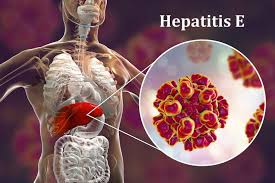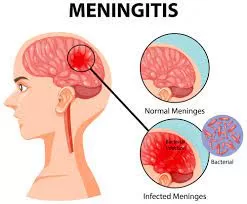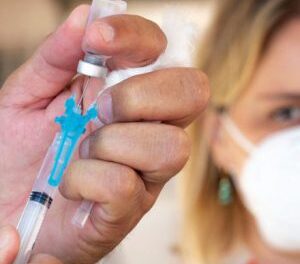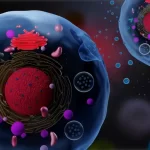Situation at a glance
Description of the situation
On 5 March 2024, WHO was notified by the Chad IHR NFP of an outbreak of hepatitis E in the eastern Ouaddai province of Chad. The initial alert of two cases of Acute Jaundice Syndrome (AJS) was raised on 2 January 2024, by a mobile clinic team supported by Médecins Sans Frontières (MSF) – Switzerland operating at the temporary high school refugee site in the Adré health district of Ouaddai province.
From 2 January to 15 February 2024, 113 AJS cases were notified from the Adré health district. Of the 113 cases, 28 (24.7%) were tested using a rapid diagnostic test (RDT) for hepatitis E by MSF – Switzerland, eleven (39.2%) of which were positive. On 19 February 2024, the Hadjer-Hadid health district, bordering the Adré district, also notified its first suspected case of hepatitis E in the Allasha refugee camp.
Between 1 and 19 March 2024, a total of 40 samples were tested by PCR at the Institute Pasteur of Dakar, Sénégal, for hepatitis E, yellow fever, dengue, West Nile fever, Zika, chikungunya, Rift Valley fever and Crimean-Congo haemorrhagic fever. Of the 40 samples, 36 (90%) were positive for hepatitis E. The median age among the confirmed cases is 36 years (range from 2 to 55 years). The male-to-female ratio among confirmed cases is 0.9 and three confirmed cases were in pregnant women.
From 2 January to 28 April 2024, a total of 2092 suspected hepatitis E cases including seven deaths (CFR 0.3%) were reported from two health districts of the Ouaddai province, namely, Adré and Hadjer-Hadid. Among the 2092 suspected cases, 103 (4.9%) were from the host community and 1989 (95%) were reported from seven refugee camps and transit sites located in five health areas of the Adré health district (Aboutenguésite, Ambelia site, Hilouta camp, Lycée d’Adré site and Metché camp) and Hadjer-Hadid health district (Allasha camp and Arkoum camp). Most cases have been reported from the Adré health district in Lycée d’Adré site (966; 46.2%), Aboutengué camp (531 cases;25.4%) and Metché camp (347 cases; 16.6%). Males (1160 cases; 55.4%) are the most affected. A total of 27 pregnant women (1.3%) have been reported among the suspected cases. The most affected age groups are 6-17 years (1113 cases) and 18-59 years (500 cases), representing 53.2% and 23.9% of the suspected cases respectively.
Hepatitis E often occurs in humanitarian settings such as in areas affected by conflict and in displacement sites. Since January 2024, suspected cases of hepatitis E have been reported from camps hosting Sudanese refugees and Chadian returnees in the Ouaddai province of eastern Chad. Limited access to safe drinking water and inadequate sanitation and hygiene increases the risk of hepatitis E virus outbreaks in humanitarian settings such as war zones and camps for refugees and internally displaced people. The last hepatitis E outbreaks reported in Chad affected the Southeastern province of Salamat in 2017, with more than 1800 cases and 23 deaths recorded, and the southwestern province of Tandjile in 2021 with over 380 cases and two deaths reported.
Epidemiology
Hepatitis E is a liver disease caused by the hepatitis E virus (HEV). Hepatitis E is found worldwide and is common in countries of Sub-Saharan Africa and Asia with limited access to adequate safe drinking water, poor sanitation and personal hygiene, limited health services or in areas of humanitarian emergencies.
HEV is transmitted by the fecal-oral route, mainly through contaminated water. The risk factors for hepatitis E are related to poor sanitation conditions, which allow the virus excreted in the feces of infected subjects to reach water intended for human consumption. The infection resolves spontaneously in 2-6 weeks with a 0.5-4% lethality. Fulminant hepatitis, a severe liver function impairment caused by HEV, is more common in pregnancy. Pregnant women, especially in their second and third trimesters, are at increased risk of acute liver failure, fetal loss, and mortality. The case-fatality rate can be as high as 10%-50% in women in their last trimester of pregnancy.
Public health response
- The Public Health Emergency Operations Centre in Chad has been activated and an Incident Manager has been nominated by the national health authorities.
- A response plan has been developed to guide response activities and help with resource mobilization.
- Response activities are ongoing in the affected districts with partners support (WHO, MSF Spain, MSF Switzerland, UNICEF, WFP, UNHCR), including strengthened epidemiological surveillance, laboratory confirmation of cases, case management, infection prevention and control (IPC), water, sanitation and hygiene (WASH), risk communication and community engagement (RCCE).
- WHO deployed a multidisciplinary team in Adré to support setting up the response (coordination of health partners, harmonization of line lists, sample collection and shipment to Institute Pasteur of Dakar, etc).
- Community health workers have been trained by WHO and MSF Switzerland to support case detection, active case search and community sensitization in refugee and returnee camps.
- Borehole construction, pit latrine construction and faecal sludge emptying are being conducted with the support of WASH partners including MSF Spain and UNICEF.
- Sanitary inspections have been conducted of the water sources used by the affected populations.1
- The need to conduct vaccination is being assessed by the Ministry of Public Health and Prevention.
WHO risk assessment
The outbreak is occurring in the Ouaddai province which has been heavily affected by an influx of refugees and returnees fleeing armed conflict in neighbouring Sudan since April 2023. The majority of hepatitis E cases have been reported from the Adré health district hosting three refugee camps with an average of 50 000 refugees per camp and a temporary refugee site housing approximately 170 000 refugees (UNHCR estimate).
The risk at the national level is assessed as high due to the continuous population movements between different refugee camps and host communities; poor hygiene conditions, low access to safe drinking water and improved sanitation facilities including wastewater management as well as limited access to essential medical services in the affected camps; challenges in the management of cases among pregnant women. In addition, the limited financial capacity to effectively contain the outbreak also contributes to increasing the risk of spreading the disease in the Ouaddai province and across the rest of the country.
Although no ongoing outbreak of hepatitis E has been reported officially in countries bordering Chad, the overall risk at the regional level is considered moderate because of the continued population movements between Chad and Sudan or the Central African Republic that raise fears of the spread of the epidemic in the sub-region. At the global level, the risk is considered low.
WHO advice
Hepatitis E is a liver disease caused by the hepatitis E virus (HEV). Hepatitis E is found worldwide and is common in countries with limited access to adequate and clean drinking water, good sanitation and hygiene (hand washing with soap, environmental and domestic hygiene), and adequate health services, or in areas affected by humanitarian emergencies.
Prevention is the most effective approach against this disease. At the population level, the most important interventions to reduce the transmission of HEV and the number of hepatitis E cases are provision of safe drinking water, quality standards for public water supplies and provision of safely managed sanitation services.2 At the individual level, risks can be reduced by maintaining hygienic practices such as washing hands with clean water and soap – especially before handling food, avoiding consumption of water and/or ice of unknown purity, and following WHO hygiene practices for food safety.
To prevent the spread of hepatitis E, WHO recommends improving access to safe drinking water through water treatment and adequate sanitation. The quality of drinking water should be regularly monitored in areas affected by the epidemic. Coverage of improved latrines and safe drinking water sources should be increased to prevent open defecation and to ensure proper hand hygiene. Health promotion and prevention activities, as well as ensuring early, appropriate, and equitable healthcare services to combat hepatitis E epidemics, can help improve public health outcomes, especially in resource-limited settings. Since the incubation period for hepatitis E ranges from 2-10 weeks, cases may continue to occur up to the tenth week (maximum incubation period) even after measures to ensure safe water, sanitation and hygiene promotion have been adopted.
Interventions must target vulnerable populations by establishing or strengthening antenatal diagnosis for pregnant women with symptoms, improving the population’s hygiene conditions, strengthening national capacities for diagnosis and clinical case management, and cross-border collaboration with neighbouring countries.
Although there is no specific treatment for HEV infection, there are some important general principles for triage of persons with features of acute liver failure in need of hospital care and treatment of complications. These are addressed in WHO guidance (Waterborne outbreaks of hepatitis E: chapter on diagnosis and case management of hepatitis E in outbreak settings). There may be special situations such as outbreaks where the risk of hepatitis E or of its complications or mortality is particularly high.
To date, the only hepatitis vaccine available is the HEV 239 recombinant vaccine (Hecolin®), licensed in China and Pakistan. WHO does not make a recommendation on the introduction of the vaccine for routine use in national programmes in populations where epidemic and sporadic hepatitis E disease is common. However, WHO recommends that national authorities should consider using the vaccine to mitigate or prevent outbreaks of hepatitis E and mitigate consequences in high-risk groups, such as pregnant women.
WHO advises against applying any travel or trade restrictions based on the current information available on this event.
Further information
- Weekly report on the humanitarian and health crisis in eastern Chad linked to the influx of refugees and returnees following the Sudanese conflict (Period from 08 to 14/04/2024), available at: (link is external)
- Waterborne outbreaks of hepatitis E: Recognition, Investigation and Control, WHO 2014. https://www.who.int/publications/i/item/waterborne-outbreaks-of-hepatitis-e-recognition-investigation-and-control
- WHO: Hepatitis E vaccine position paper, May 2015, available at: https://www.who.int/publications/i/item/WER9018-185-200
- Hepatitis E vaccination: Questions and answers 1 September 2019, available at: https://www.who.int/news-room/q-a-detail/hepatitis
- Technical considerations and case definitions to improve surveillance for viral hepatitis – policy brief. WHO (2016). Available at: https://www.who.int/publications/i/item/technical-considerations-and-case-definitions-to-improve-surveillance-for-viral-hepatitis-policy
- WHO Hepatitis E: https://www.who.int/news-room/fact-sheets/detail/hepatitis-e#
- Johns Hopkins, Centre for Health Security. Available at: https://www.outbreakobservatory.org/outbreakthursday-1/1/6/2022/republic-of-south-sudan-hepatitis-e-outbreak(link is external)
- WHO EIS: Acute hepatitis E, South Sudan, April 2023. Available at: https://extranet.who.int/ihr/eventinformation/event/2018-e000214
- MSF Urgent action needed as hepatitis E spreads through Sudanese refugee camps in Chad: https://www.msf.org/urgent-action-needed-hepatitis-e-spreads-through-refugee-camps-chad(link is external)
[1] Sanitary inspection packages – a supporting tool for the Guidelines for drinking water quality: small water supplies (who.int).
[2] Safely managed sanitation: use of improved facilities that are not shared with other households and where excreta are safely disposed of in situ or removed and treated off-site.
Citable reference: World Health Organization (8 May 2024). Disease Outbreak News; Hepatitis E in Chad. Available at: https://www.who.int/emergencies/disease-outbreak-news/item/2024-DON517











